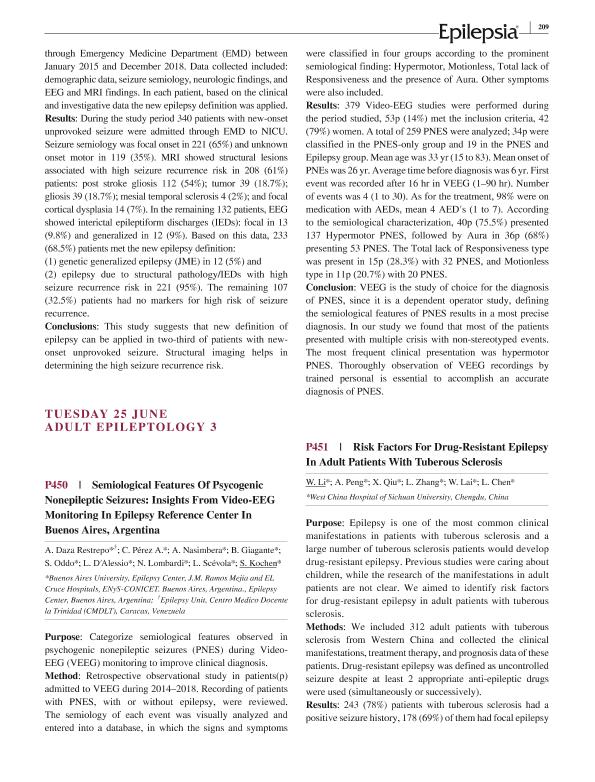Evento
Semiological Features Of Psycogenic Nonepileptic Seizures: Insights From Video- EEG Monitoring In Epilepsy Reference Center In Buenos Aires, Argentina
Daza Restrepo, A.; Pérez A., C.; Nasimbera, Alejandro ; Giagante, Brenda; Oddo, Silvia Andrea
; Giagante, Brenda; Oddo, Silvia Andrea ; D´Alessio, L.; Lombardi, N.; Scévola, L.; Kochen, Sara Silvia
; D´Alessio, L.; Lombardi, N.; Scévola, L.; Kochen, Sara Silvia
 ; Giagante, Brenda; Oddo, Silvia Andrea
; Giagante, Brenda; Oddo, Silvia Andrea ; D´Alessio, L.; Lombardi, N.; Scévola, L.; Kochen, Sara Silvia
; D´Alessio, L.; Lombardi, N.; Scévola, L.; Kochen, Sara Silvia
Tipo del evento:
Congreso
Nombre del evento:
33° Congreso Internacional de Epilepsia
Fecha del evento:
22/07/2019
Institución Organizadora:
International League Against Epilepsy;
Título de la revista:
Epilepsia
Editorial:
Wiley Blackwell Publishing, Inc
ISSN:
1528-1167
Idioma:
Inglés
Clasificación temática:
Resumen
Purpose : Categorize semiological features observed in psychogenic nonepileptic seizures (PNES) during VideoEEG (VEEG) monitoring to improve clinical diagnosis. Method : Retrospective observational study in patients(p) admitted to VEEG during 2014–2018. Recording of patients with PNES, with or without epilepsy, were reviewed. The semiology of each event was visually analyzed and entered into a database, in which the signs and symptoms were classified in four groups according to the prominent semiological finding: Hypermotor, Motionless, Total lack of Responsiveness and the presence of Aura. Other symptoms were also included. Results : 379 Video- EEG studies were performed during the period studied, 53p (14%) met the inclusion criteria, 42 (79%) women. A total of 259 PNES were analyzed; 34p were classified in the PNES- only group and 19 in the PNES and Epilepsy group. Mean age was 33 yr (15 to 83). Mean onset of PNEs was 26 yr. Average time before diagnosis was 6 yr. First event was recorded after 16 hr in VEEG (1–90 hr). Number of events was 4 (1 to 30). As for the treatment, 98% were on medication with AEDs, mean 4 AED′s (1 to 7). According to the semiological characterization, 40p (75.5%) presented 137 Hypermotor PNES, followed by Aura in 36p (68%) presenting 53 PNES. The Total lack of Responsiveness type was present in 15p (28.3%) with 32 PNES, and Motionless type in 11p (20.7%) with 20 PNES. Conclusion : VEEG is the study of choice for the diagnosis of PNES, since it is a dependent operator study, defining the semiological features of PNES results in a most precise diagnosis. In our study we found that most of the patients presented with multiple crisis with non- stereotyped events. The most frequent clinical presentation was hypermotor PNES. Thoroughly observation of VEEG recordings by trained personal is essential to accomplish an accurate diagnosis of PNES.
Palabras clave:
EPILEPSY
,
INMUNO
Archivos asociados
Licencia
Identificadores
Colecciones
Eventos(ENYS)
Eventos de UNIDAD EJECUTORA DE ESTUDIOS EN NEUROCIENCIAS Y SISTEMAS COMPLEJOS
Eventos de UNIDAD EJECUTORA DE ESTUDIOS EN NEUROCIENCIAS Y SISTEMAS COMPLEJOS
Citación
Semiological Features Of Psycogenic Nonepileptic Seizures: Insights From Video- EEG Monitoring In Epilepsy Reference Center In Buenos Aires, Argentina; 33° Congreso Internacional de Epilepsia; Bangkok; Tailandia; 2019; 209-209
Compartir
Altmétricas



